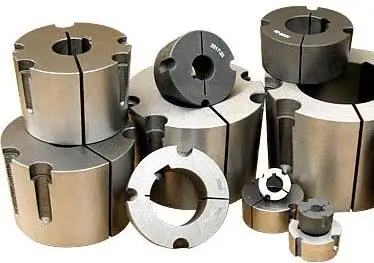china taper bush
Get rid of all screws, oil threads, and the position of the established screws or threads, below the head of the cap screws.
Insert screws into the holes that are threaded on the bushing side, as shown in Determine 2. In sizes exactly where washers are identified under the screw head, be certain to use these washers. Please observe that there ought to constantly be a single screw left in excess of that is not utilized when taking away the bushing.
Tighten the screws alternately until the bushing is loosened in the hub. If the bushing does not loosen right away, tap on the hub to help remove.
Elimination of a Taper Lock bush, which includes Martin or Fenner Taper Lock bush elements, is as follows:
The Taper Lock bush demands to be completely cleaned, getting rid of all traces of oil, grease, dust, and steel filings. Clear the shaft, the bore, the outside the house of the bushing, and the bore of the hub in which the bush is to be put in into, making certain the bush is taken out from the hub, should it already be put in.
Check out the bushing to ensure all surfaces are free of charge from nicks and burrs, and guarantee the bushing has no indications of cracking or fatigue. Location the bushing into the hub and match 50 % holes to make total holes. It is crucial to be aware that the holes need to have to be matched, not the threads. Each and every gap will be threaded on a single facet only.
Oil threads, the position of the established screws or threads, and under the head of the cap screws. Then location the screws loosely into the holes that are threaded on the hub-facet, as revealed in Determine 1 under.
Make sure that the Taper Lock bush is cost-free in the hub, then slip the assembly onto the shaft and track down in the sought after position. Insert the properly sized key into the shaft keyway, guaranteeing the crucial is a push suit 
Screws must be tightened alternately and evenly until all screws are pulled up and the bushing is square into the hub.
Making use of a hammer and block, or sleeve, in opposition to the massive stop of the Taper Lock bush will aid to keep away from damage to the bushing. Flippantly faucet towards the busing to make sure it is seated squarely. The screws are then tightened even more. A torque wrench is used to tighten the screws alternatively and evenly till they are all to the advisable torque environment. This data is accessible from the set up sheet that accompanies any new Taper Lock bush. See case in point chart under (determine three), or question for this data at any CBC workplace.
Repeat this alternate hammering and screw tightening right up until the specified torque is achieved and no lengthier requires
Fill the holes that are not utilized with grease or silicone sealant to prevent them from filling with dust and/or rust.
Are you thinking about finding out more regarding exactly how china taper bush, see our website at http://www.wly-transmission.com/Bush/Keyway-20sizes-20for-20taper-20bushings.htm if so.